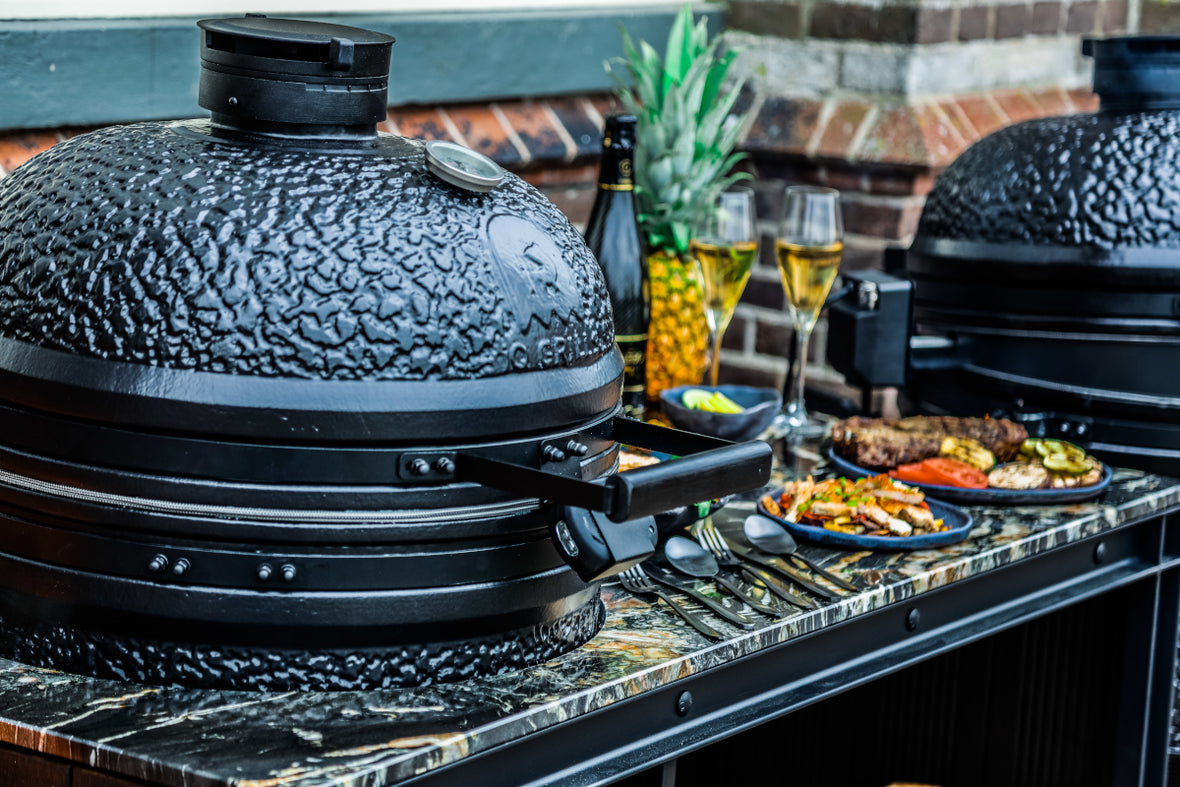
Buying a new BBQ? Explore the different BBQ Types and their features
Malcolm Grima
When it comes to barbecuing, the grill is more than just a tool; it's the heart of the entire experience. The type of grill you choose can dramatically influence the flavor, texture, and overall quality of your barbecue. Whether you're a seasoned pitmaster or a backyard grilling enthusiast, understanding the different types of BBQ grills can elevate your outdoor cooking game. In this post, we'll explore the three main fuel types—gas, wood, and charcoal—and dive into some of the most popular grill styles, including Kamado ceramic grills, Parilla grills, and Tuscan grills.

Gas Grills: Convenience Meets Control
Gas grills are the go-to choice for many barbecue lovers due to their convenience and ease of use. Powered by propane or natural gas, these grills heat up quickly and allow for precise temperature control. This makes them ideal for both quick weeknight meals and more elaborate weekend barbecues.

Pros:
- Ease of Use: Gas grills ignite with the push of a button and reach cooking temperatures within minutes.
- Temperature Control: Dial-in heat settings allow for precise cooking, making it easier to manage complex dishes that require varying temperatures.
- Clean Burning: Gas burns cleaner than charcoal or wood, resulting in less smoke and fewer flare-ups.
Cons:
- Flavor: While convenient, gas grills often lack the smoky flavor that many barbecue enthusiasts crave.
- Cost: High-end gas grills can be expensive, and the cost of propane can add up over time.
Charcoal Grills: The Classic Choice
Charcoal grills are beloved by purists for the rich, smoky flavor they impart to food. Cooking over charcoal requires a bit more skill and patience, but the reward is a deep, authentic barbecue taste that’s hard to replicate with gas.

Pros:
- Flavor: Charcoal grills produce a signature smoky flavor that’s synonymous with traditional barbecue.
- High Heat: Charcoal burns hotter than gas, making it ideal for searing steaks and other meats.
- Versatility: From low-and-slow smoking to high-heat searing, charcoal grills can do it all.
Cons:
- Time-Consuming: Charcoal takes longer to light and heat up, which can be a drawback for quick meals.
- Mess: Handling charcoal can be messy, and cleaning up ash afterward requires extra effort.
Wood Grills: Authenticity and Rich Flavor
Wood grills are the ultimate choice for those who want the most authentic, rich barbecue flavor. Whether using hardwood logs or wood chips, cooking with wood infuses food with a deep, smoky essence that’s unmatched by other fuels.

Pros:
- Flavor: Wood provides the most authentic barbecue flavor, with different woods (like hickory, mesquite, or apple) offering distinct tastes.
- Traditional Cooking: Wood grilling is steeped in tradition and offers an immersive cooking experience.
- Versatility: Wood can be used in various types of grills, adding a rich dimension to both low-and-slow and high-heat cooking.
Cons:
- Skill Required: Managing a wood fire takes practice, as maintaining a consistent temperature can be challenging.
- Time and Effort: Like charcoal, wood requires more time to light, maintain, and clean up after cooking.
Kamado Ceramic Grills: The Versatile Performer
Kamado ceramic grills are a modern take on ancient clay cooking vessels. These grills are highly versatile, capable of grilling, smoking, and even baking. The thick ceramic walls provide excellent heat retention and distribution, making them perfect for a wide range of cooking styles.

Pros:
- Heat Retention: Kamado grills maintain consistent temperatures for hours, making them ideal for slow cooking.
- Versatility: Whether you’re grilling a steak, smoking ribs, or baking bread, Kamado grills can do it all.
- Durability: Built to last, these grills are often passed down through generations.
Cons:
- Weight: Kamado grills are heavy and difficult to move, which can be a drawback for those who need portability.
- Cost: High-quality ceramic Kamado grills can be expensive, but they’re a long-term investment.
Parilla Grills: The Argentine Tradition
Parilla grills are a staple in Argentine and Uruguayan barbecue culture. These open grills feature adjustable grates that allow cooks to control the distance between the meat and the heat source, usually hardwood embers. The result is perfectly cooked, smoky meats with a crisp exterior and juicy interior.

Pros:
- Flavor: Cooking over wood embers adds a deep, smoky flavor to the meat.
- Control: The adjustable grate gives precise control over cooking temperature and intensity.
- Cultural Experience: Using a Parilla grill is more than cooking; it’s participating in a rich culinary tradition.
Cons:
- Size: Parilla grills are often large, requiring ample outdoor space.
- Complexity: Mastering the art of cooking on a Parilla grill takes practice and patience.
Tuscan Grills: Simple and Rustic
Tuscan grills, also known as "griglia," are a rustic, straightforward type of grill typically used over an open fire. Originating from Italy, these grills are simple metal grates placed over a wood fire, perfect for cooking meats and vegetables with a robust, smoky flavor.

Pros:
- Simplicity: The minimalist design makes Tuscan grills easy to use and maintain.
- Portability: Tuscan grills are lightweight and easy to move, making them great for camping or outdoor gatherings.
- Flavor: Cooking over an open wood fire delivers a strong, authentic flavor.
Cons:
- Limited Control: Unlike other grills, Tuscan grills offer limited control over temperature and cooking conditions.
- Exposure to Elements: Since Tuscan grills are open, wind and weather can affect cooking.
Final Thoughts
Choosing the right grill is about matching your cooking style with the features that best suit your needs. Whether you prefer the convenience of a gas grill, the rich flavor of charcoal, or the authenticity of wood, there’s a grill for every barbecue enthusiast. Kamado ceramic grills offer versatility and excellent heat retention, Parilla grills provide a traditional and flavorful experience, and Tuscan grills bring a simple, rustic charm to outdoor cooking. Whichever you choose, the right grill can turn every meal into a memorable culinary adventure.
















